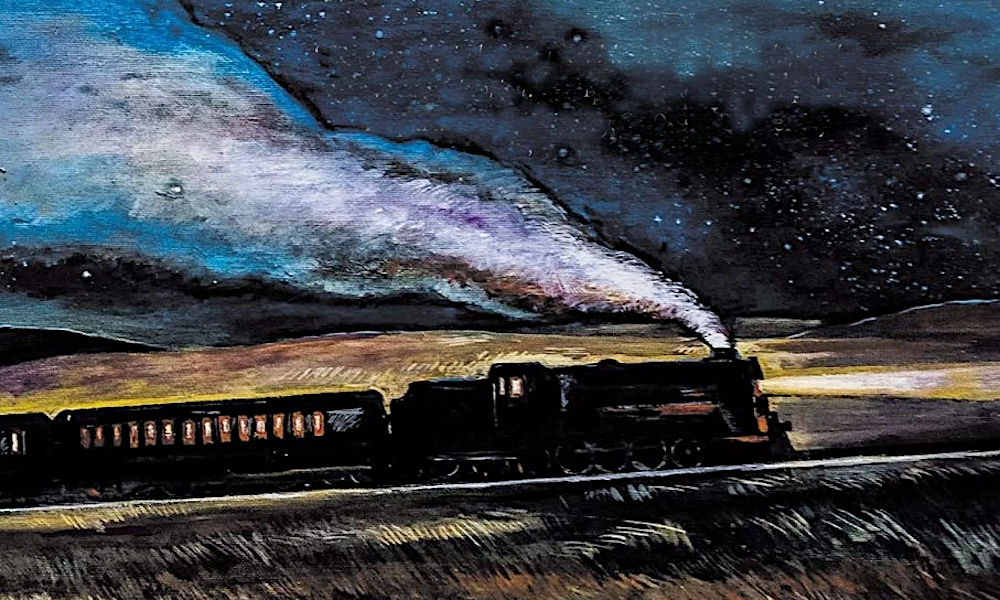
The Night Trains by Charles van Onselen
Introduction
The Night Trains: Moving Mozambican Miners to and from the Witwatersrand Mines, 1902-1955 is a historical non-fiction novel written by Charles van Onselen and published by Jonathan Ball Publishers in South Africa in 2019. Van Onselen is a South African historian. He has written extensively on 19th and 20th century Southern African history and is the author of numerous acclaimed volumes. He currently serves as a Senior Research Fellow at the Centre for the Advancement of Scholarship at the University of Pretoria. Van Onselen's work is a testament to his expertise in Southern African history, and the book has received critical acclaim, including the 2021 ASSAf Humanities Book Award. The cover, designed by Michel Botha, features a train piercing through the night, set against a vibrant sky ablaze with stars and a crescent moon. The darkness is punctuated by the fiery hues of smoke and the ethereal glow of celestial lights surrounding the moon, creating a striking visual contrast of the peace and mystery of the night.
Plot Summary
The book chronicles the experiences of black Mozambican miners in South Africa during its industrial revolution from 1900 to 1960s and their journey from Ressano Garcia, on the Mozambique border, to Booysens Station, Johannesburg and back. Through four sections, Van Onselen details the historical context of the mining revolution, the recruitment and transportation of Mozambican labourers, the harsh conditions they faced in the mines, and the exploitation they suffered on their journey back home. The book sheds light on the human cost of the migrant labour system, reflected in songs like "Shosholoza" and "Stimela," which depict the harsh realities faced by the miners. The Night Trains is a transnational story of human exploitation that exposes the harsh realities of the migrant labour system.
Analysis
The book explores several major themes, including:
-
Capitalism:
The book exposes the railway system's role in exploiting black labour for the mining industry's wealth, while shrouding the inhumane conditions faced by Mozambican miners. As Onselen notes, "mirroring the brutal logic of industrial capitalism, this was a system of transport designed to maximise profit at the expense of the health, well-being and even the lives of those it conveyed." This stark reality underscores the system's ruthless prioritisation of profit over human life, a chilling precursor to the dynamics of contemporary capitalism. Furthermore, Onselen highlights the colonial administration's glaring neglect of the Sul do Save region, where taxes were harvested without corresponding investments in education, health, infrastructure, or welfare facilities. Consequently, the taxes extracted from the miners yielded no benefits for their communities, exemplifying the extractive and exploitative nature of the system. -
Colonialism:
The intercolonial agreement between South Africa and Mozambique enabled the recruitment and transportation of black labourers, highlighting the mutually beneficial yet exploitative nature of colonial policies. Both countries gained monetarily, but at the expense of the Mozambican migrants' well-being. They implemented policies to exploit African labour, particularly in mining. These policies denied labourers basic rights, restricted their movement, and maintained cheap labour, with no prospect of citizenship or permanent residency. Onselen argues that “there was something in the practice of colonialism that might have helped prepare the way mentally for the European Barbarism of the Twentieth century.” This implies that the brutal methods and ideologies employed by colonial powers in their colonies normalised or desensitised people to violence, oppression, and dehumanisation, ultimately contributing to the atrocities committed in Europe. This highlights the complex and dark legacy of colonialism with profound impacts on societies and individuals. -
Racism, Xenophobia, and Apartheid:
The book reveals how the railway system enforced segregation and apartheid, with black workers transported under oppressive conditions and denied basic rights. This system paved the way for the apartheid era, with policies designed to maintain racial hierarchies and control over the black population. Onselen argues that it “played a small pioneering role in undergirding the region-wide industrial revolution that rested first on segregation, and then, much later, on apartheid.” The relationship between South African and Mozambican communities was marked by exploitation, with South Africans taking advantage of Mozambican migrants on their journey back home. This dynamic underscores the complex role migrants have played in South Africa's industrial development. Labour migrants had metal dog tags worn around the neck, bearing a Portuguese passport number, eerily foreshadowing the pass laws later enforced during apartheid in South Africa. -
Human Cost:
The Night Trains highlights the devastating human cost of this exploitation, including physical and emotional tolls on black labourers, as well as the cultural impact on communities. Mozambicans were often exposed to inhumane living conditions both on the trains to and from the mines and at the mining communes. This resulted in disease outbreaks and, in extreme cases, death. Onselen states that migrants faced a “family-deprived, high-stress and frequently loveless environment”. Migrants were often degraded and treated as “freight” or “machines”, affecting their mental health. The combination of isolation, stress, and lack of compassion in their daily lives would have exacerbated feelings of alienation, anxiety, and despair.
Conclusion
Overall, "The Night Trains" is a powerful exploration of the migrant labour system and its legacy of exploitation, racism, and xenophobia. Van Onselen's work provides a nuanced understanding of the complex relationships between South Africa and Mozambique and the ongoing impact of this history on contemporary society. While South Africa gained tremendously from the exploitation of migrants in the early 20th century, Mozambique continues to struggle with 70 percent of the population living in poverty and constantly amongst the poorest countries in the world.
Photo by the Johannesburg Book review Modified by SIHMA
Categories:
Tags:

